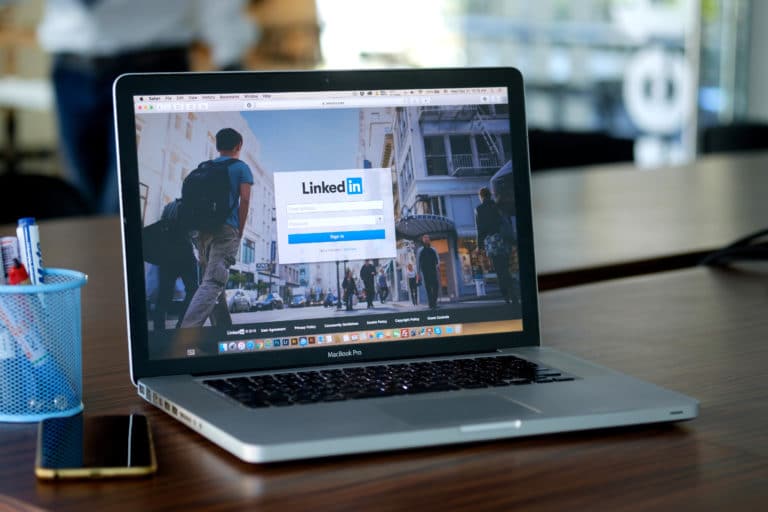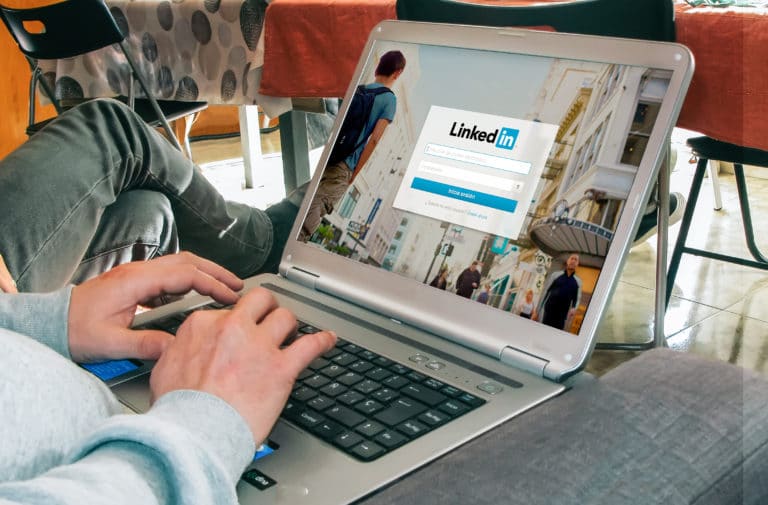This article was updated in February 2025 to reflect updated best practices. We’re staying on top of all things LinkedIn and social selling, so be sure to bookmark and check back regularly!
When you look at most examples of good LinkedIn posts, you’ll find content designed for massive brands that already have gigantic followings.
But what about LinkedIn post examples for those of us who don’t have a million followers already? Maybe only a few thousand.
Startups. Sales reps. Business owners. Founders. Marketing leaders. Recruiters.
What about when you need actual, quantifiable leads from your LinkedIn presence, and you don’t have the benefit of a household name?
That’s our focus for this article.
We don’t have a massive following or a giant budget. If we make a post on LinkedIn and it doesn’t generate leads, then we know we’ve made a mistake.
For context, as of 2025, over 30% of our new business had been sourced from LinkedIn. And that ratio has remained remarkably consistent through to today, as we scale.
Because RevenueZen works mainly with growing B2B companies who use LinkedIn as a source of revenue, not just another place to show off their brand: our focus is on strategies that lead to revenue and leads, not just impressions.
(BTW – looking for a social selling workshop for your entire team? We’ve got you covered.)
A massive amount of innovation in B2B demand generation and marketing is developed by smaller, leaner, and scrappier entrepreneurs and companies, before being adopted by more conservative, slower-moving larger brands with much larger budgets. Basically, growth marketing in a nutshell.
I’m not sharing the Gary Vaynerchuk’s of the world, with millions of followers. These examples of good LinkedIn posts are for people who don’t have a massive following (and who need results). At RevenueZen, we’re all about lean strategies that anyone can run, not just the big brands and personalities.
A few things to take note of with these examples:
- You don’t need massive engagement to generate leads.
- You don’t need a massive following to be effective, so long as you are connected with people in your target market
- Just about anyone in your company can run this strategy, not just C-levels or founders (including sales reps and revenue leaders, just ask us how)
- You’ll notice none of these posts contain links, videos, or images. That can work sometimes but results come from becoming being authentic, not just resharing rehashed content from somewhere else.
- We use our CEO’s own LinkedIn posts as examples because we can verify that we’ve generated leads from them (and also to show that you don’t need to be huge to generate revenue on LinkedIn).
- Throughout 2020-2025, the new LinkedIn algorithm began rewarding longer posts that keep people on-page for longer, so keep that in mind as you write.
Let’s dive into these 12 examples of good LinkedIn posts!
Good LinkedIn Post Example #1: Be Personal
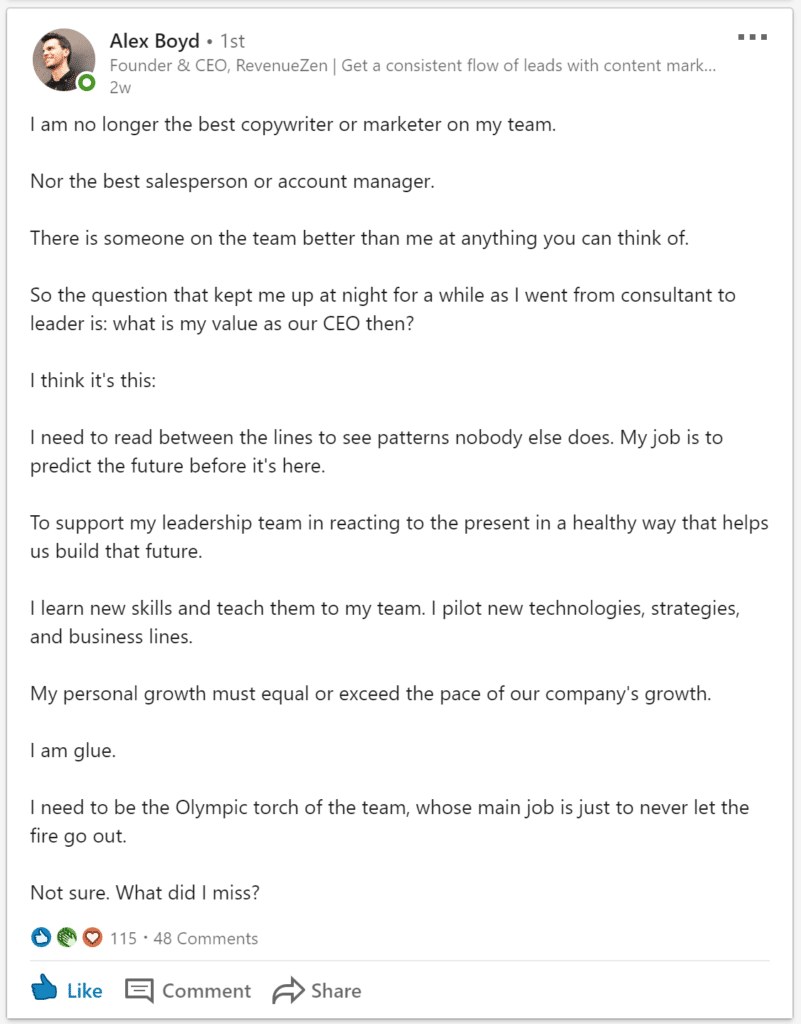
In the sales and marketing world, the common advice is to avoid be too me-centric in your writing. It’s much better to talk about your prospects and what they are going through. Usually, this is great advice.
And yet, this post, which starts off 50% of sentences with “I” got great engagement and led to several leads reaching out proactively to RevenueZen.
Why?
LinkedIn posts work best when they are personal. I usually describe the best content as “professionally relevant personal content.”
People are on LinkedIn to do business, network with current/future/past colleagues, share thoughts and ideas on their industry, and — most relevant to this article — learn from leaders in their industry and network.
This “I”-centric post works because people in his network follow and engage with him specifically because they want to see what is happening in the brain of the CEO and founder of an agency that helps startups with growth, sales, and marketing.
Then, when people engage with his content, the post is shared across their network.
Because his profile headline and content are optimized well, people see his authentic content, see that his headline is relevant to what they do, click his profile, and then contact RevenueZen (either by sending him a direct message or coming to our site).
The takeaway: Be authentic with your content. Let your profile do the selling.
Good LinkedIn Post Example #2: Be Relevant
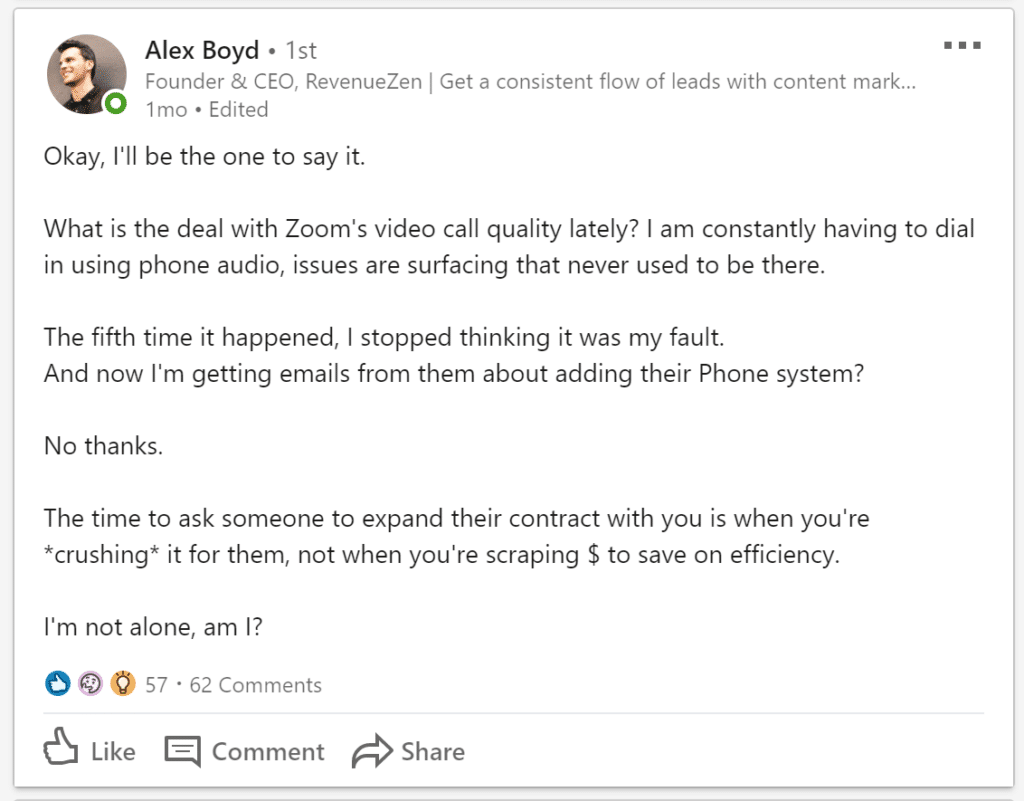
Here’s a post that is decidedly NOT about RevenueZen. At the time, we (and others in our network) had been having issues with Zoom, usually a great video conferencing tool. With our target LinkedIn audience and existing network, this was a very timely (and relevant) topic, given how important video calls are to day-to-day business in the startup, sales, and marketing worlds.
When you are thinking of timely content, you don’t necessarily need to watch the news. Think about what is affecting you and your network and write about that.
Building your audience and then writing good LinkedIn posts that generate leads takes authentic content that people relate to. You should know, and narrow down your audience to be as specific as possible. Then write to them.
It doesn’t really matter if the subject-matter is irrelevant for the majority of people on LinkedIn. They aren’t your target market. Your target market is the very specific subset of people in your network who would might good prospects, and the people connected to them.
Good LinkedIn Post Example #3: Don’t Be Too Self-Promotional
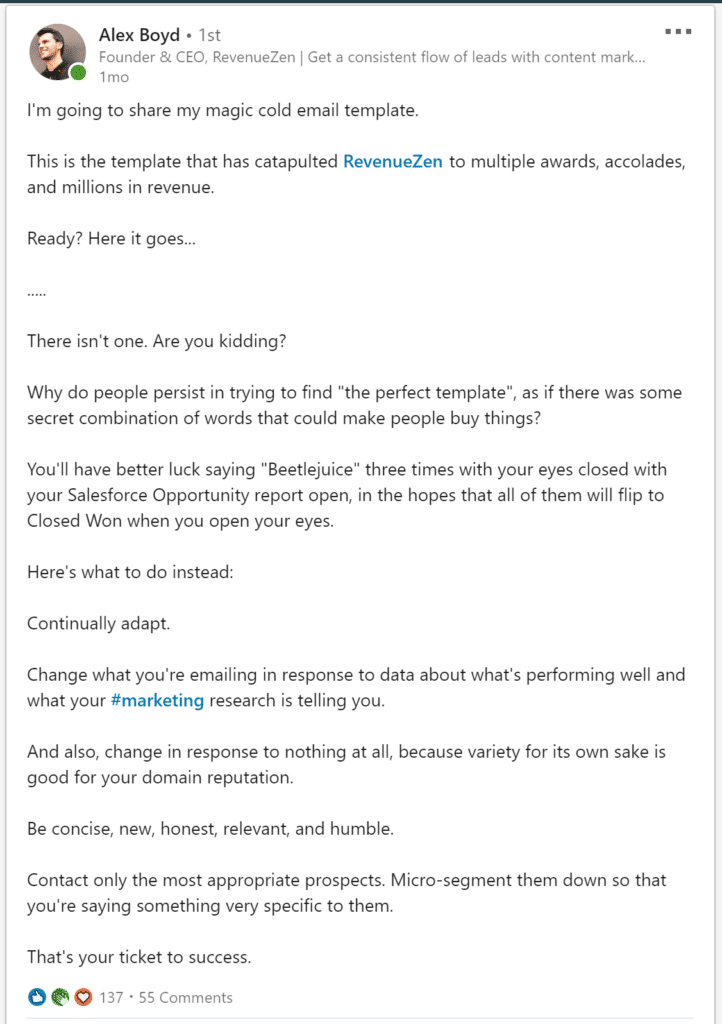
Self-promotional content performs poorly on the LinkedIn feed. Why? Because the seem like ads and people don’t want to engage organically with more ads.
The LinkedIn feed is powerful because it allows business people to share the insights and thoughts that are relevant to their network.
This post gets close to being self-promotional but ended up generating several high-quality leads for us. The difference between this post and self-promotional content is that we are being tongue-in-cheek about our “accolades.”
Instead of leading people down the path of showing off how great we are, we use that as the hook, only to surprise them with a counter-intuitive point of view.
Good LinkedIn Post Example #4: Mix It Up
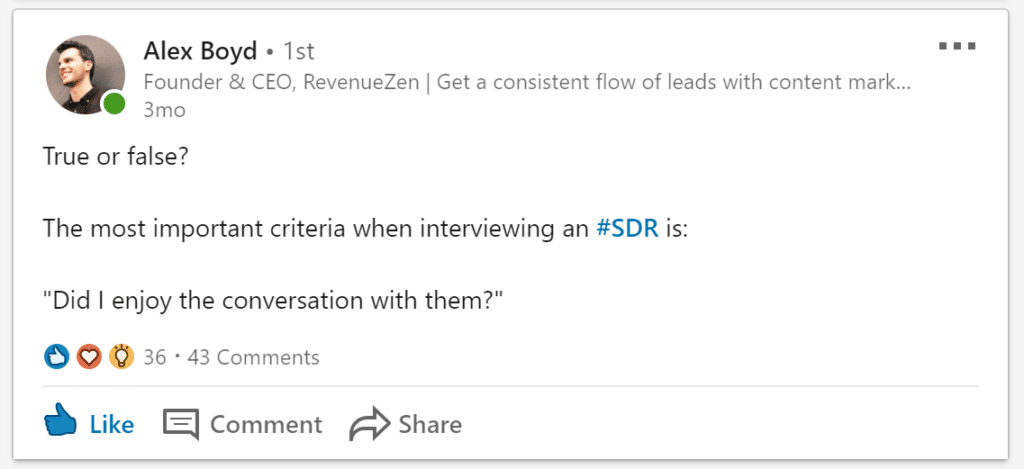
Sometimes, short posts that ask a relevant, somewhat charged question lead to good engagement. In this case, the post is only “charged” from the point of view of somebody hiring/interviewing and SDR.
Use caution with this kind of post.
If you use it too much, people won’t actually engage with you because it seems like you’re just fishing for likes/comments. However, if you have built up an engaged following using more personal posts like the other examples of good LinkedIn posts in this article, you can benefit from injecting a little variety into the length and style of your posts.
Similarly, if you know that you have an engaged group of people within your network who regularly comment on your posts, you can use this style of post to engage them with a pointed question that they can express their opinion on.
Good LinkedIn Post Example #5: Be Controversial
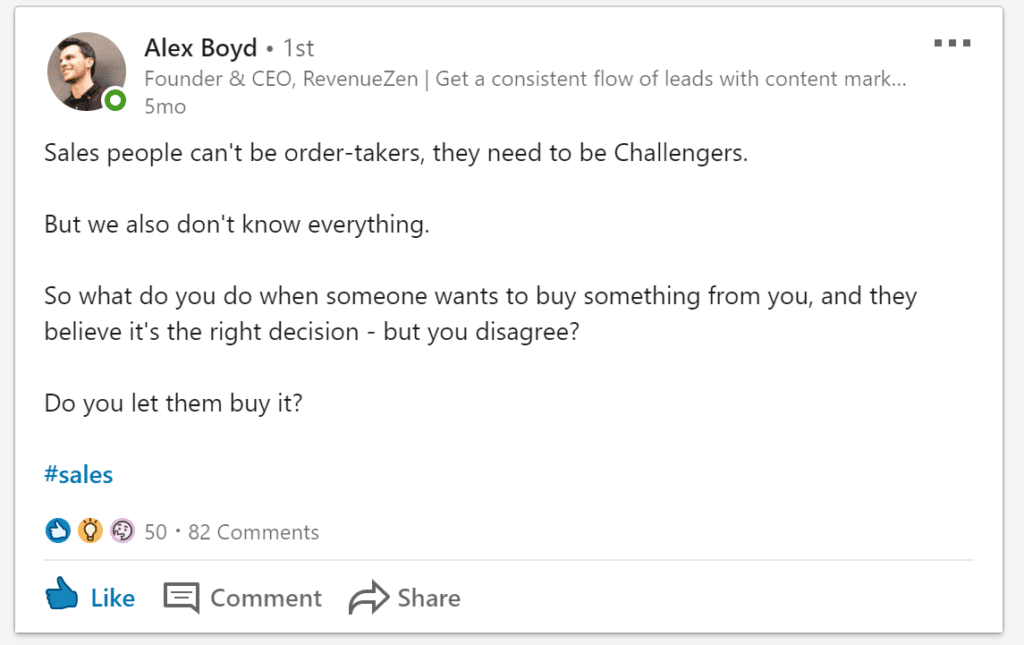
This post is similar in length to the last one but it relies a little less on pre-existing engagement from followers. In this post, even though it’s much shorter than others, there is enough content to spark a conversation.
Sometimes, it can pay to be somewhat controversial.
Challenging a commonly held view in your industry is a great way to simultaneously show your insight while also engaging your network. Likewise, taking common wisdom, and then showing a less-commonly known interpretation of that wisdom works well to challenge people to view their industry in a way they hadn’t before.
Most of the time, nuances in “business advice” can get glossed over in favor of nicer-sounding phrases that are more consumer-friendly.
In this instance, the popular opinion is around salespeople not being order-takers. The nuanced discussion takes place as Alex digs a little deeper into the topic, challenging his network to look at the subject a little closer.
One way to generate LinkedIn post ideas like this is to take any common advice or phrase that you’ve seen in your industry, and add a layer of nuance to it, or take a different position.
Good LinkedIn Post Example #6: Use Stories
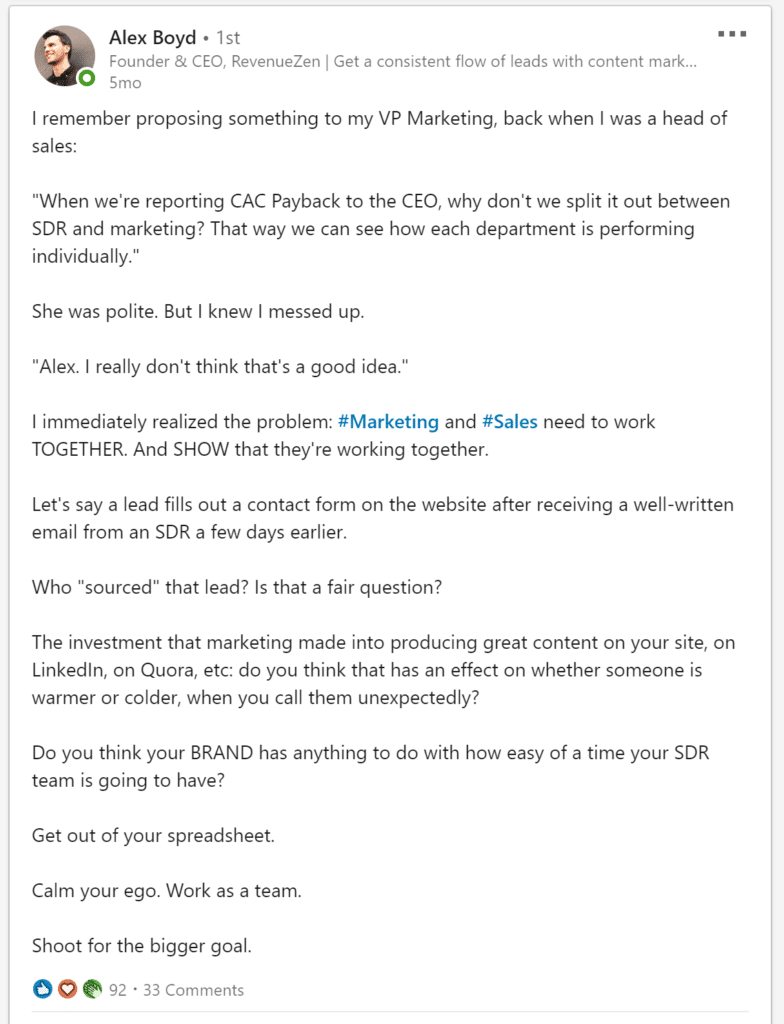
Stories!
Everyone has stories to tell.
Use events and experiences from your professional past to give people insight. These stories work because they are professionally relevant while still being personal and authentic.
It’s real.
In this case, it’s a professional story, but you can use completely personal stories, so long as you connect them somehow to the professional audience that you’re writing for.
This post could have easily been written without the personal element. Instead of telling the story as something that happened to him, he could have just given the advice.
But by embedding his insights into a personal story, all of a sudden, the post is far more engaging and fun to read. It hooks you in a way that non-stories don’t.
When coming up with your own LinkedIn post ideas, you can pull these stories from everywhere — customer conversations, calls with prospects, meetings with your former boss, your board, your employees, or even a conversation you overheard at a restaurant.
While you’re at it, take a look at these 7 rules for storytelling in sales over at SalesHacker.
Good LinkedIn Post Example #7: Educate People
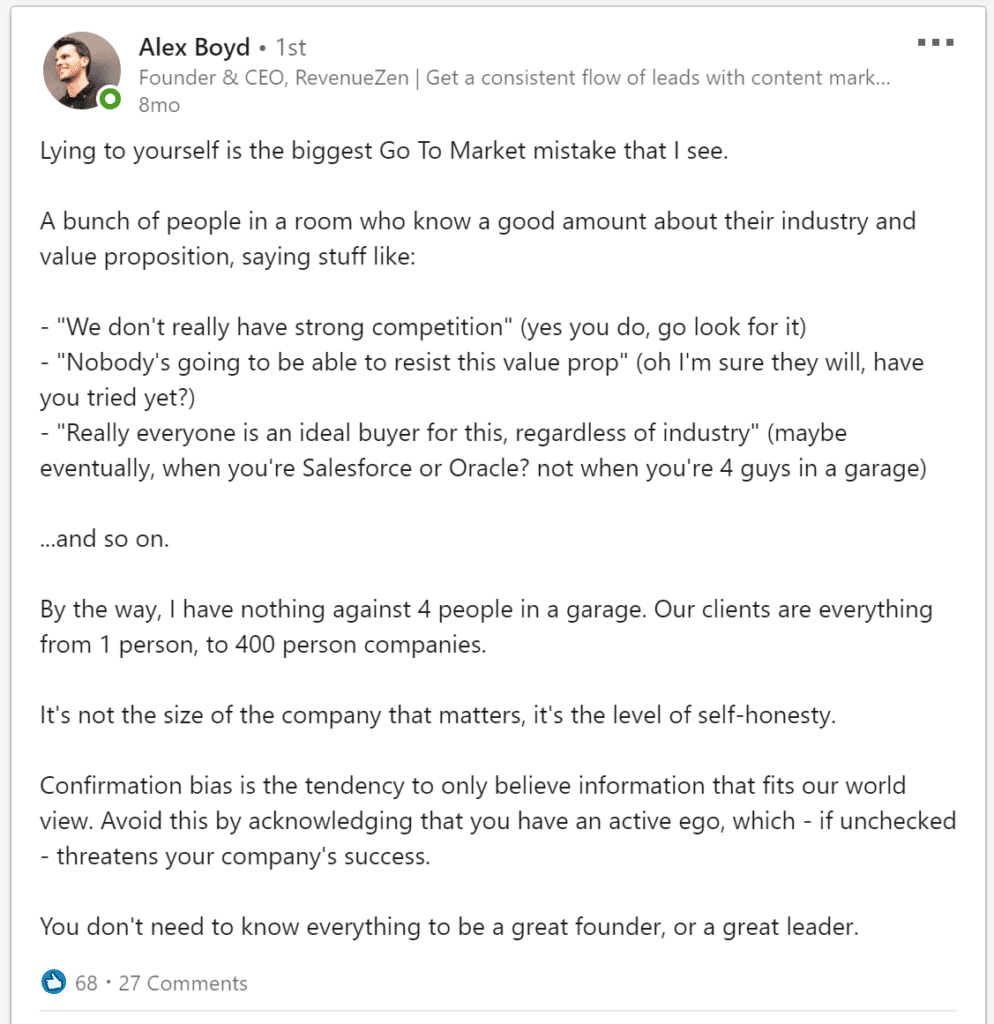
Here is a great example LinkedIn post that directly challenges people while educating them and providing a unique point-of-view based on real-world experience.
This post does well because we are giving people a hard truth. The tone is a little harsher than usual, but the value is there because the post still educates.
One mistake you can make with this style of post is accidentally slipping into complaining mode, or being overly critical without being constructive. Challenging your audience and network’s belief requires walking a fine line between being controversial without being negative. The beliefs you want to challenge are related to misconceptions in your industry, not society.
Most great business leaders are known for their willingness to challenge the commonly accepted wisdom in their industry. They are outspoken innovators who refuse to accept the status quo.
You may not be the next Steve Jobs, but you can certainly become known within your LinkedIn network (which serves as a proxy for your industry as a whole) as a person who thinks differently. When that happens, people will start to see and trust you when they see you and your company in other contexts.
Every week, we’ll get contacted by someone whose CEO or founder tells their team to contact us because they’ve read our LinkedIn posts. They come to us with a level of pre-built trust that simply doesn’t happen from ads. CEOs aren’t telling their team to contact somebody spits out the same content as everyone else. They want to talk to people who teach them something and challenge their way of thinking. This is true for every industry, no matter how small or large.
Good LinkedIn Post Example #8: Hint at Something Great
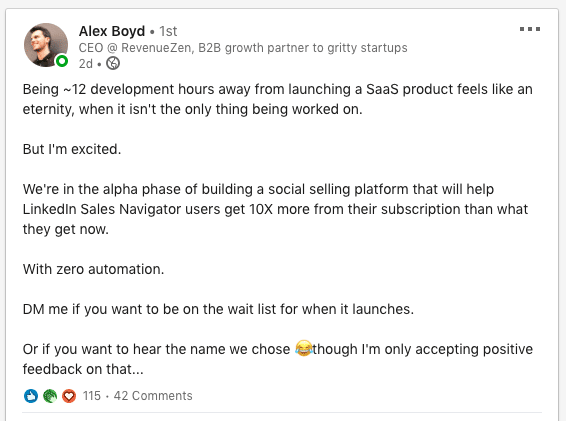
If you’ve been steadily building up your network with your target audience, through organic connections and/or outbounding, you likely have a network of folks who are interested in what you have to say or what you have to offer.
The reason this post generated 40 SaaS leads is because it generated intrigue without “feature spitting”. If you have a new release coming out: tease it! The post acknowledges that we’re in the early stages of the product, but people love feeling like they’re early adopters or that they’re part of the origin of something. It also offers a bit of humility at the end. It makes your connections aware not only that you’re releasing something new, but that they’re exclusively chosen to be a part of its beginnings.
Good LinkedIn Post Example #9: Provide Concrete Numbers

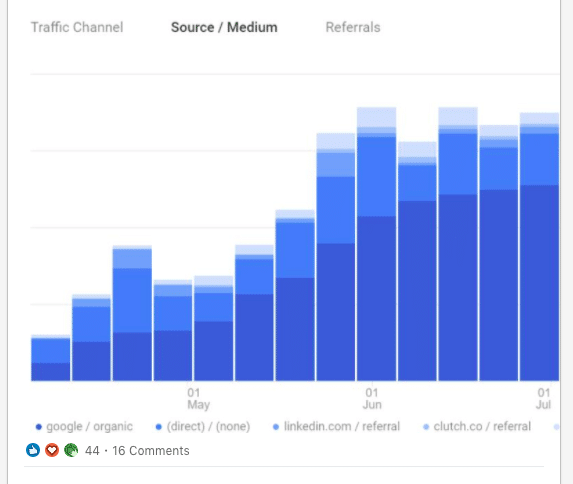
We received 4 solid leads from this post. Considering it only has 44 likes and 16 comments, that’s a pretty good ratio. The reason this post performed well is that it’s both honest and concrete.
It offers a quick list of three different strategies we’ve used to grow our organic traffic that others can implement. Alex also offers the opportunity to DM to talk further about it. If using the “DM to talk more” CTA (which we don’t always recommend) make sure that your post was about something very specific that people can DM you about, vs. a blanket statement post with a “Let’s Talk!” at the end.
Good LinkedIn Post Example #10: Not a Good Fit
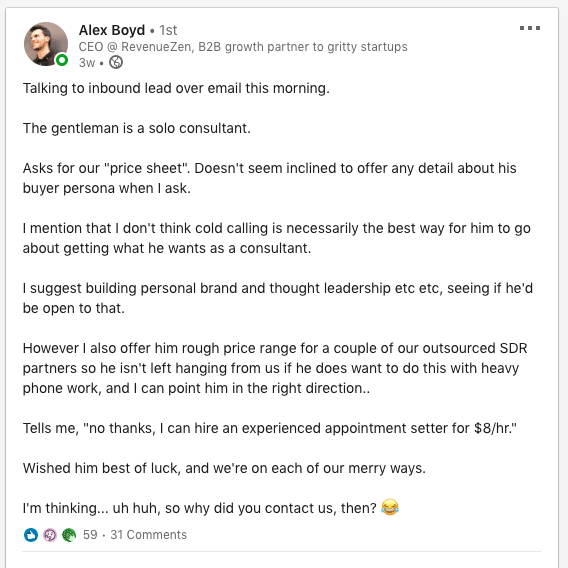
Here, Alex gave an example of someone we wouldn’t work with. He was honest that he knew the lead wasn’t a good fit, and he didn’t use any sales techniques to try to convince him to work with us. This shows other connections that we work in an honest manner, with clients we know are a good fit. It gives peace of mind to prospects.
Use this style of post sparingly and where it makes sense.
Good LinkedIn Post Example #11: Showing Results
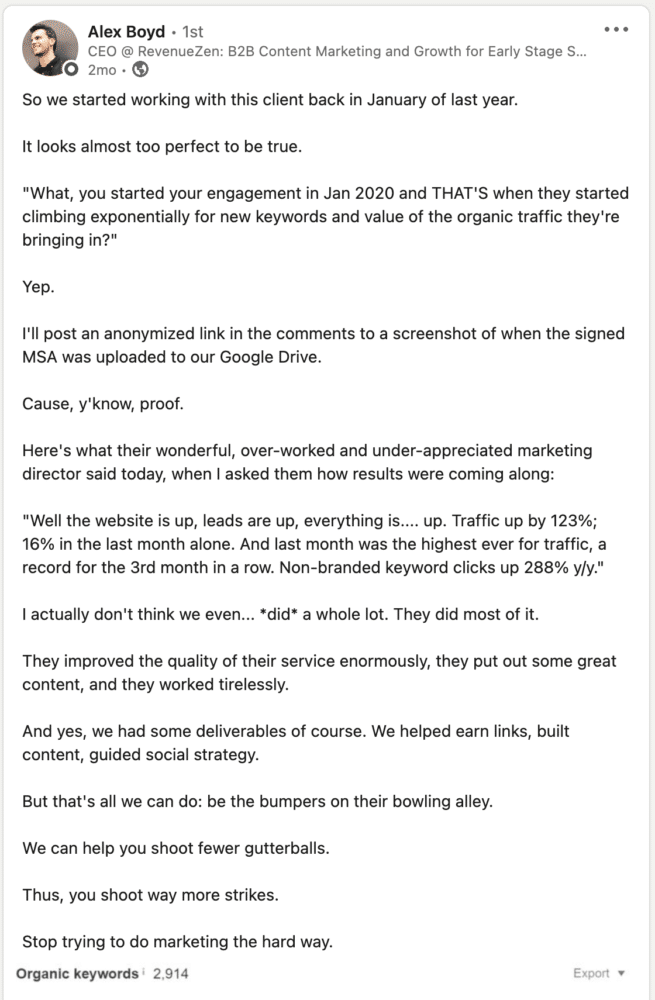
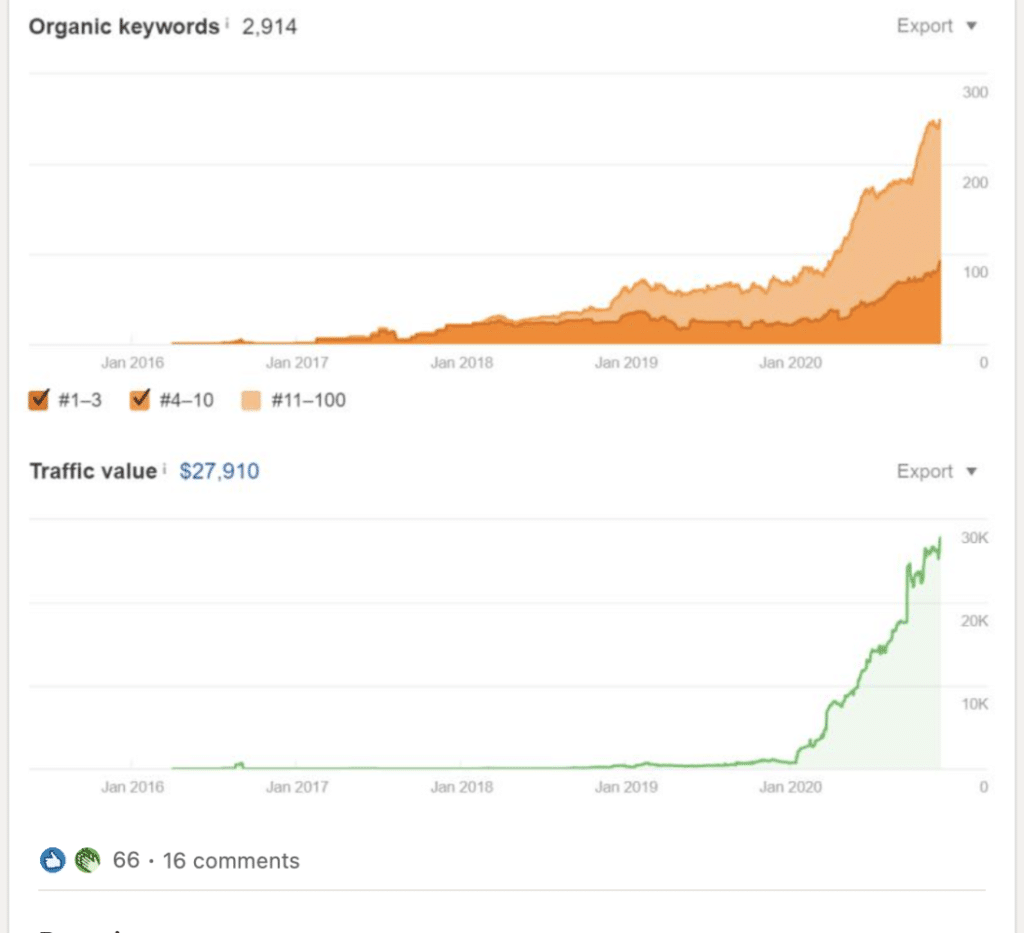
You’ve worked hard and achieved great results. That deserves to be celebrated. And why keep that a secret? If you’ve achieved results that other potential clients might be interested in, it’s absolutely worth sharing. More than just showing the results, talk about how you achieved them. If you can remember specific talking points the client had, that’s an even bigger value add. There’s immense value in showing how the conversation went.
The goal here isn’t to brag and gloat. The goal is to show great results, help others see what their future could look like, and to build credibility. Think.. “show, don’t tell.”
Use this style sparingly.
Good LinkedIn Post Example #12: Showing Results
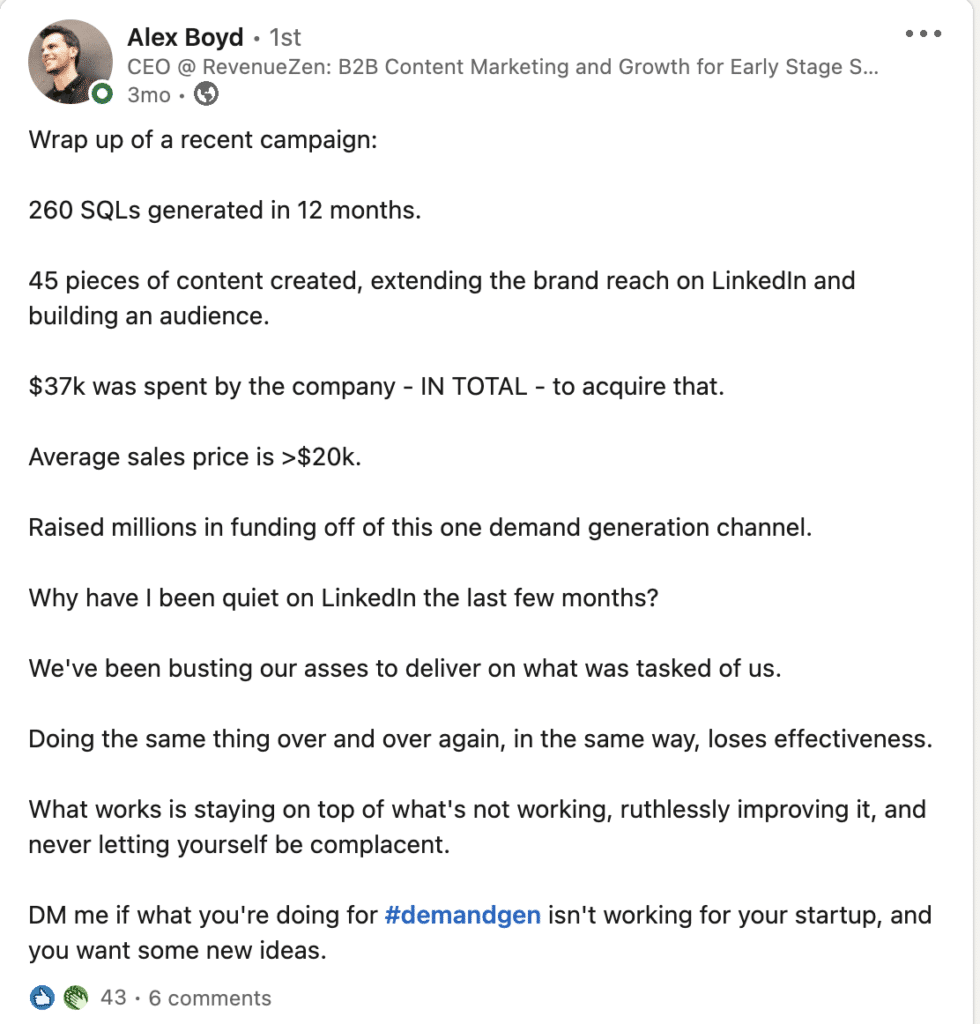
What’s a good engagement rate on LinkedIn posts?
2-3% is a good engagement rate for a typical post, defined as # Engagements as a percentage of total Views. But, if you get tiny or massive engagement, your mileage will vary.
This graph shows the engagement rate of four of my recent posts, over their first week:
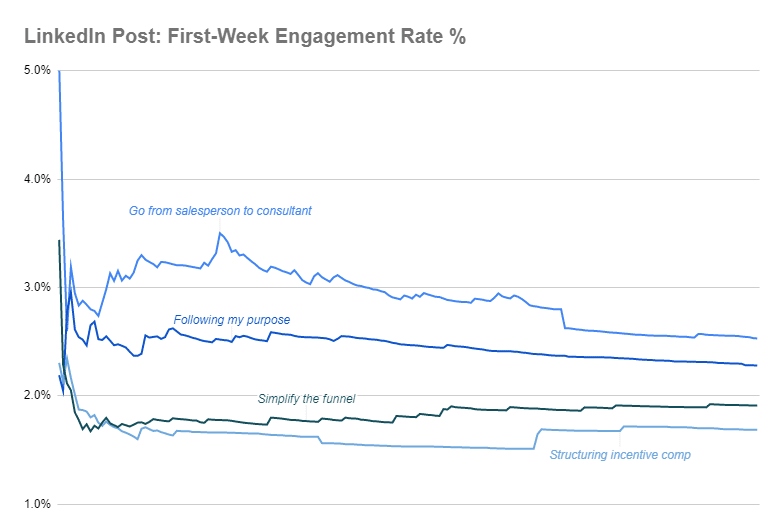
As you can see, engagement varies for different posts. It’ll be very high at first, then usually drop off over time.
This is because LinkedIn shows your post to the people most likely to engage with it, first. Then it displays the post to people a bit less likely, and so on.
Takeaways
For years, social media has been focused on how B2C brands can communicate with consumers, but with LinkedIn, we’re entering a world where B2B professionals can establish themselves as experts without the backing of massive funding.
If you have a unique point-of-view, interesting insights, or expertise to share with people in your industry, then do it. Start writing. Posting to LinkedIn is free.
If your content is good, then people will find it. The best content is authentic and comes from your actual experiences in life.
Be sure to have a group of “LinkedIn friends” that know you and support you and engage with your content, and whose content you engage with, too. This is incredibly important – without this, you will almost never succeed with your content.
Don’t use these examples of good LinkedIn posts as a template to copy. Use them as inspiration and real-world guidance on LinkedIn content that has actually generated leads.
Every single day, we’re help founders, sales and marketing leaders, and individuals tell their story on LinkedIn and what we’ve learned is — everyone has a different voice, different style, and unique stories, but the key is consistency and authenticity.
No matter what LinkedIn does with their feed from an algorithmic perspective, people still crave authentic content like the example LinkedIn posts above. Get help from our expert team on your social selling strategy.



